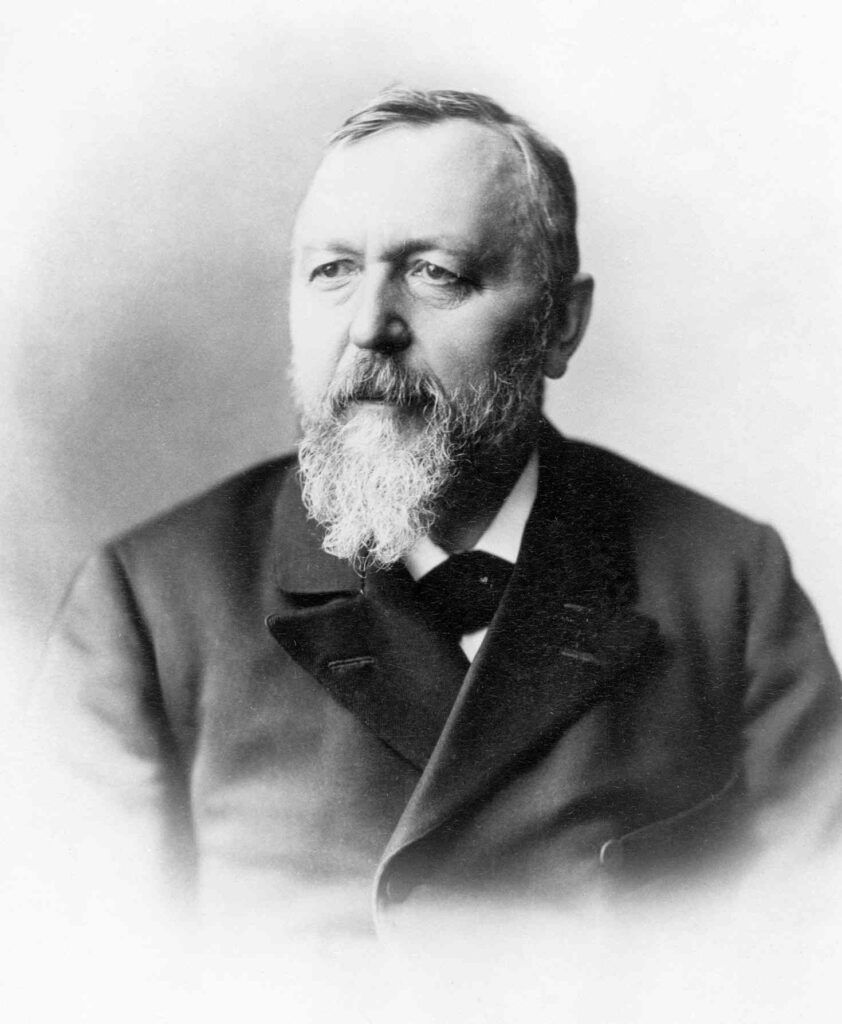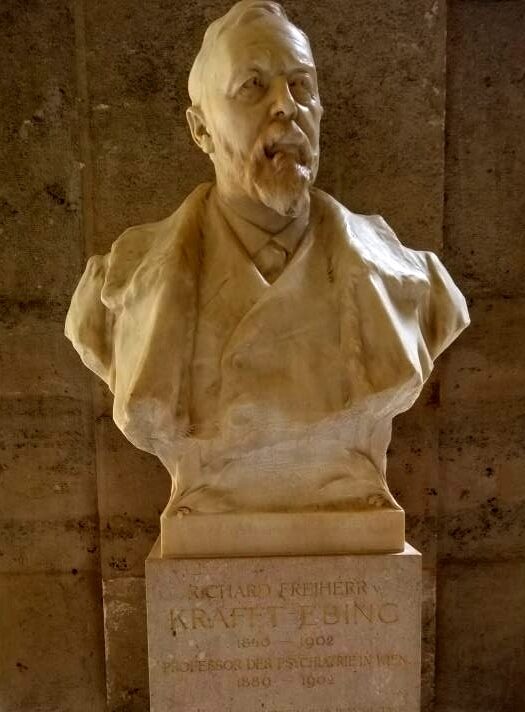
Krafft-Ebing was the most influential German-speaking psychiatrist of the late 19th century. His books “Textbook of Forensic Psychopathology” and the three-volume “Textbook of Psychiatry” were the most important pieces of psychiatric literature. Today, his name appears as a rand note in few historical texts, and on the whole, the secondary literature on him is sparse.
Those historians who singled out one of Krafft-Ebing’s specific interests have, without exception, explored his work on sexuality. For many historians, Krafft-Ebing made his name with “Psychopathia Sexualis,” and it is doubtful whether he would be remembered had he not written this particular book.
Writing “Psychopathia Sexualis” during the Victorian era was a revolutionary undertaking, as the subject of sexuality was taboo in polite society and also neglected by the medical establishment. Krafft-Ebing took the risk of pioneering research on sexuality years before Freud entered the scene.
Within the historical context, Krafft-Ebing’s several enduring personal contributions stand out and deserve recognition. He rejected the notion of psychiatry as a mere auxiliary science, emphasising that clinical psychiatrists should work with facts. Krafft-Ebing consistently advocated for the humanisation and liberalisation of the treatment of psychiatric patients and, in particular, those deemed to have disorders related to their sexuality.
Krafft-Ebbing. Biographical Note
Richard Freiherr von Krafft-Ebing was born on the 14th of August 1840 in Mannheim, in the Grand Duchy of Baden in South Germany. He was the oldest son of Friedrich Carl Conrad von Krafft-Ebing, a higher district administrator who had studied law at Heidelberg, and his wife Clara Antonia Mittermaier.
On the paternal side, the Catholic family was of Austrian origin. They have been ennobled by Empress Maria Theresia in 1770 and further elevated to the rank of Imperial Baron by Emperor Franz II, Emperor of Austria in 1805. Richard von Krafft-Ebing’s title was Freiherr from birth. Richard’s family had a strong military tradition. Some key aspects of his upbringing include experiences in a household dominated by service to authority.
His mother was a daughter of the famous legal reformer and professor of law at Heidelberg University, Carl Joseph Anton Mittermaier. Archives supply the names and birthdates of his three younger siblings—but little else about Krafft-Ebing’s youth and nothing about the family atmosphere. The family moved away from Mannheim and settled around 1842 in Eberbach, a small town close to Heidelberg, where Krafft-Ebing’s father was a higher district administrator.
Krafft-Ebing himself attended the local school in 1848, but he then moved back to Heidelberg, around the age of 10 or 12. It is also known that in this period Richard’s mother died when he was only 14 (and his father married her older sister). He lived in the house of his grandfather Mittermaier, which has been described as a “centre point of life in Heidelberg” and as putting him into a “mentally stimulating atmosphere.” Mittermaier was probably the single most important influence on Krafft-Ebing animating his grandson in the direction of legal psychiatry.
University Studies and Early Medical Career
Richard von Krafft-Ebing’s journey through the world of medicine and psychiatry is a remarkable one. It was in Heidelberg that Richard von Krafft-Ebing, following his high school graduation, pursued a career in medicine. In 1863 he completed his education at Ruprecht-Karls-Universität Heidelberg, achieving a Doctor of Medicine degree with “summa cum laude” honours for his thesis on “Die Sinnesdelirien” (“The Sensory Deliriums”).
After completing his high school education, Krafft-Ebing pursued his medical studies in Heidelberg and Zurich. It was in Zurich that he encountered the renowned clinician Griesinger, who became his mentor, igniting Krafft-Ebings interest in psychiatry. Griesinger imparted the clinical method’s subtle art, a neuro-pathological foundation for psychiatric illnesses, and a commitment to holistic therapeutic approaches for mental disorders.
Assistant Physician Role in Baden State Mental Hospital, Illenau

Krafft-Ebing gained practical experience in the broad field of mental health while working as an assistant physician at the Baden State Mental Hospital Illenau from 1864 to 1868 under the guidance of Christian Roller and Karl Hergt. Christian Roller, the compassionate first Medical Director of the Illenau Mental Asylum, served as another crucial mentor for Krafft-Ebing.
Under Roller’s guidance, Krafft-Ebing conducted his doctoral research on a neuropsychiatric topic related to delirium. In his 1867 work, “Recognition of Doubtful Mental States,” he introduced the concept of “obsessions” into the field, as well as the later concept of “twilight states.”
After his studies, he embarked on brief internships in Vienna, Prague, and Berlin. In 1864, he was offered an assistant position at the Illenau Mental Asylum in Baden by Ch. Roller, where he spent four years.
Work in Baden Baden and Strassburg from 1868 until 1873
In 1868, von Krafft-Ebing settled as an independent neurologist in Baden-Baden. At the outset of his career, he cared for his younger, seriously ill brother, Friedrich, for several months. After losing the battle to save his 24-year-old brother’s life, he embarked on a restorative and art-filled journey across southern Europe, visiting psychiatric and neurological institutions along the way.
During the Franco-Prussian War (1870/71), he initially served as a field doctor with the rank of captain in the Baden Division, later becoming a hospital doctor in the Rastatt fortress. His observations, particularly among typhus patients, were documented in a special treatise.
Following the war, he was entrusted with overseeing the electrotherapeutic station in Baden-Baden, primarily focusing on the neurological rehabilitation of wounded soldiers. This period of his life laid the foundation for his future work in psychiatry and neurology.
In 1875, while still in Strasbourg, his first major work, “Textbook of Forensic Psychopathology,” was published. This was followed by the “Textbook of Psychiatry” in 1879 and his most famous work, “Psychopathia Sexualis,” in 1886, which soon became a standard textbook in the field of “sexual pathology” in the 19th century.
After a short stay as a neurologist in Baden-Baden and military service during 1870/71, Krafft-Ebing accepted an appointment as an associate professor of psychiatry at the newly established University of Strasbourg.
Professorships at Universities of Graz and Vienna
Kraft-Ebing departed from Strassbirg in 1873 to assume the directorship of the Feldhof Mental Asylum in Graz, which also entailed the professorship of psychiatry at the University of Graz. During his tenure at Feldhof and the Graz clinic, von Krafft-Ebing laid the foundation for his worldwide fame, attracting patients from many countries. To cater to the growing number of patients from affluent families, he established a private clinic in Mariagrün near Graz, which was considered exemplary for its time.

Krafft-Ebing continued his academic journey until 1889, when he was appointed to lead the I Psychiatric Clinic in Vienna. In 1892, he took over the II. Psychiatric Clinic from Theodor Meynert.
Krafft-Ebing’s work coincided with a crucial period in the scientific and institutional development of psychology as a specialised field. His research was influenced by Roller’s patriarchal asylum psychiatry and Griesinger’s brain anatomical school, while in Illenau, his work was characterised by the integration of clinical observation with neurophysiological and psychological principles.
Scientific Work in Vienna
One of his early significant monographs introduced the concept of “obsessions” into psychiatric terminology. In his work he delved into topics of mental disorders following head injuries, the fundamentals of criminal psychology, and forensic psychopathology. He believed that psychiatry should primarily serve as a descriptive rather than an explanatory science.
Krafft-Ebing’s reputation as a leading Austrian psychiatrist solidified with works like “Lehrbuch der gerichtlichen Psychopathologie” (“Textbook of Forensic Psychopathology”) and the three-volume “Lehrbuch der Psychiatrie” (“Textbook of Psychiatry”) published in 1879. The latter saw seven editions until 1903. However, it was his 1886 publication, “Psychopathia Sexualis,” that garnered global acclaim. Its overwhelming popularity led to a second edition within a year, focusing specifically on “contrary sexual sensations” (homosexuality).
Krafft-Ebing’s four-volume work, “Contributions to the Field of Psychiatry and Neurology” (1897-99), aimed to complement his textbook. It introduced terms like the “twilight state” and described “self-determination capacity” in neuroses.
Krafft-Ebing’s Contribution to Forensic Psychiatry
Richard von Krafft-Ebing played a significant role in the emerging field of forensic psychiatry, where psychological motives behind criminal acts were explored and their relevance to legal responsibility was considered. He stands as a prominent figure in German-speaking psychiatry during this historical period, known both for championing the general concept of degeneration and for founding forensic psychiatry inspired by it. His famous monograph, “Psychopathia Sexualis,” is also integral to this context.
His interest in forensic psychiatry was evident in his emphasis on examining the perpetrator, not just the act itself. In 1872, before his appointment as a professor of psychiatry at the University of Graz, he published “Grundzüge der Kriminalpsychologie” (“Fundamentals of Criminal Psychology”).
Research on Sexuality
The modern concept of sexuality, as we understand it today, began to take shape in the late nineteenth century. Key figures in this development were Richard von Krafft-Ebing and Albert Moll. They played a pivotal role in reshaping the perception of sexuality during this period.
This transformation of sexuality was closely tied to the recognition of sexual diversity, particularly within the medical and psychiatric communities. Prior to this era, acts considered immoral deviations from the norm were the primary focus. However, around 1870, psychiatrists began to shift their attention to the idea that these behaviours were not merely temporary deviations but rather inherent and pathological conditions.
During the late nineteenth century, numerous psychiatrists collected and published case histories to classify and explain various deviant sexual behaviors. This marked the emergence of medical sexology, allowing to diagnosis sexual disorders.
Redefining Understanding of Human Sexuality
Krafft-Ebing and Moll were at the forefront of this shift in perspective. They moved away from considering deviant sexuality as a symptom of underlying mental disorders and instead viewed it as an integral and continuous aspect of human sexuality. Their writings laid the foundation for our modern understanding of human sexuality, predating similar views expressed by Sigmund Freud.
Sexuality was recognised as a fundamental human force contributing significantly to happiness and restrained by morality. Krafft-Ebing occupies a pivotal role in the societal discourse on sexuality during the latter half of the 19th century.
In the introduction to his clinical-forensic study, Krafft-Ebing acknowledged the profound influence of sexual sensations as the foundation for the development of social emotions. He emphasised the societal responsibility of his medical practice, stating, “Few people fully realise the immense influence that sexual life gains on feelings, thoughts, and actions in individual and social existence.”
At that time sexual abnormalities, among them homesexuality, were seen as “malformations” and defined as cerebral functional disorders following the degeneration theory.
Krafft-Ebing on Sexual Deviations
As a professor of psychiatry at the universities of Graz and Vienna, he achieved worldwide fame with his book, “Psychopathia Sexualis,” first published in 1886. This groundbreaking work opposed the moralistic attitudes of the Victorian era, where such topics were rarely discussed openly.
In “Psychopathia Sexualis,” Krafft-Ebing introduced a systematic classification of sexual disorders, which gave a structured framework to understand behaviours that deviated from societal norms. In this book Krafft-Ebing identified four main categories of sexual psychopathologies within the group of “cerebrally induced neuroses”:
- paradoxia, sexual desire at the wrong time of life, such as childhood or old age
- anesthesia, insufficient desire
- hyperesthesia, excessive desire
- paraesthesia, sexual desire for the wrong goal or object. This included homosexuality (or “contrary sexual desire”), sexual fetishism, sadism, and masochism
Krafft-Ebing categorised sexual perversions more narrowly as “paraesthesia’s,” and in all editions of “Psychopathia Sexualis,” homosexuality, referred to as “contrary sexual sensation,” occupied a central position. It was acknowledged that homosexuality could coexist with love and intellect but was considered a “malformation.”
Krafft-Ebing recognised the tragic complexity of this condition as a human affliction and advocated for a respectful approach, which was remarkable for the time.
In subsequent editions, additional sub-forms of sexual deviations were defined, including sadism, masochism, and fetishism. These perversions were characterised by a predominantly dominant, exclusive, and fixed pursuit of pleasure unrelated to responsible reproductive sexuality, which Krafft-Ebing regarded as perversions.
Krafft-Ebbing and Sigmund Freud
At the beginning of his career, Sigmund Freud faced financial constraints, leading him to accept a position as the head of paediatric neurology at the first public Children’s Hospital in Vienna under Max Kassowitz’s leadership in 1886. He held this position until 1896 while also maintaining a private practice. During this period, Krafft-Ebing moved to Vienna and became a professor in 1889, taking over the I. Psychiatric Clinic and, in 1892, the II. Psychiatric Clinic, succeeding Freud’s academic mentor, Theodor Meynert.
Freud and Krafft-Ebing maintained an open collegial and scientific exchange, with Freud being well-versed in Krafft-Ebing’s writings, especially those on sexual pathology. Despite working outside the university at an independent institution and in his private practice, Freud remained highly ambitious in his scientific pursuits and continued to publish prolifically. This period marked a significant intersection of his and Krafft-Ebing’s careers, where both made substantial contributions to the field of psychiatry and psychology.
Krafft-Ebing and Freud on Sexuality
Krafft-Ebing’s pioneering empirical work paved the way for a more systematic exploration of human sexuality by subsequent scholars like Moll, contributing to the development of modern sexology.
Krafft-Ebing made a distinction between perversity and perversion. He saw perversity as a contingent, immoral conduct of otherwise normal individuals, while perversion indicated inevitable and permanent pathological traits that were an integral part of one’s nature.
While developing the cornerstone of modern sexology, especially in regards to differenttion and classification of sexual abnormalities, both, Krafft-Ebing and Moll were wrong in their view on the rootcauses of the sexual disorders. Both were strongly influenced by the bio-medical approach in German psychiatry as well as by the current theory of degeneration, adhering to biogenetic and evolutionary explanations of sexuality.
This concept has been corrected by Freud’s sexual theory. According to Freud, sexual identity is closely tied to one’s psychological development. This implies the notion that the libido consists of “component drives” and that normal heterosexuality is the result of a healthy conversion of various impulses, whereas perversions arise from developmental disturbances. The life and work of Richard von Krafft-Ebing Psychiatrist biography highlight his pioneering studies. His research on Richard von Krafft-Ebing sexual disorders laid the foundation for understanding deviations in sexual behavior, and his seminal work, Richard von Krafft-Ebing Psychopathia Sexualis, remains influential in sexual psychology.
This reevaluation of sexual identity has profound implications for how society perceives and addresses sexual deviance, acknowledging it as an intrinsic aspect of human diversity rather than mere aberration.
Dispute on Psychoanalytical Theory
On April 21, 1896, Freud presented the cornerstones of his psychoanalytical theory, in particular his findings on male hysteria, to the Vienna Medical Society, which received a hostile reception, causing tremendous outrage and rejection. In a letter to Wilhelm Fließ, Freud wrote:
“A lecture on the aetiology of hysteria in the Psychiatric Society was met with icy reception by the donkeys, and Krafft-Ebing made the peculiar judgement: It sounds like a scientific fairy tale.”
Nevertheless, there was no lasting tension between Krafft-Ebing and Freud. Both continued to dedicate their latest works to each other with collegial appreciation and personal dedication.
It was Richard von Krafft-Ebing, along with Hermann Nothnagel, the Professor of Internal Medicine at the University of Vienna, who advocated for Freud’s professorship at the ministry.
Krafft-Ebing. Theory of Degeneration versus Environmental Influencess
However, it would be Freud who would transform the relevant works of Krafft-Ebing, especially his research on sexuality and sexual pathology. Freud’s explicit etiological focus on early sexual traumas as the cause of hysterical syndromes not only posed a fundamental challenge to the still-dominant theory of degeneration proposed by Krafft-Ebing but also connected perversion and hysterical neurosis into an overarching pathogenetic model. Freud later referred to neurosis as the “negative of perversion.”
The paramount etiological significance of sexual trauma in all “psychoneurosses,” depending on their timing in individual development, would evolve into a novel model of psychodynamic psychiatry. The psychoanalytic movement would ultimately contribute to the unfortunate obscurity that befell both Krafft-Ebing’s work and his legacy for many decades.
Richard von Krafft-Ebing. Summary
Richard von Krafft-Ebing’s work in the field of forensic psychiatry and his detailed exploration of sexual deviations marked a significant shift in psychiatric understanding. He combined a neurological basis with a psychological perspective, recognising the complexity of human sexuality.
His approach laid the foundation for a more compassionate and nuanced consideration of individuals with abnormal sexualities, which was groundbreaking in his time. He consistently advocated for the humanisation and liberalisation of the treatment of psychiatric patients and, in particular, those deemed to have disorders related to their sexuality.
Despite the controversies surrounding his work, Krafft-Ebing’s “Psychopathia Sexualis” remained an authoritative reference on sexual disorders and significantly impacted the field of sexual psychology. He played a crucial role in paving the way for the establishment of modern sexual science, as later exemplified by figures like Sigmund Freud.
Today, Krafft-Ebing is considered the true founder of modern sexual pathology, coining terms for clinical phenomena like perversions, sadism, and masochism. His forensic and sexual pathological conclusions influenced profoundly anthropological, social, and legal sciences in the years to come.


